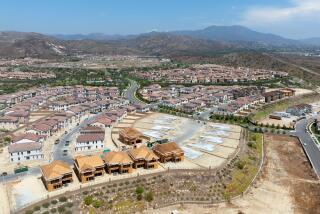IRVINE : County to Create New Wetlands
What it takes Mother Nature hundreds of years to create with wind and rain, Orange County parks employees will attempt to do in three years using bulldozers and artificial irrigation.
Grading work that began this summer on the east side of William R. Mason Regional Park and a temporary irrigation system scheduled for installation next month are intended to help create 80 acres of artificial wetlands. They will be across Culver Drive from the more manicured section of the park.
Besides creating a natural park for the public, the county is using the project to determine if large artificial wetlands can be created to attract declining species such as the California gnatcatcher, said Denton D. Turner, design manager for the harbors, beaches and parks division of the county’s Environmental Management Agency.
The project also includes artificial wetlands planned for the Aliso/Wood Canyons Regional Park in Laguna Niguel.
The goal at Mason Park is to dig closer to the water table and create channels for the natural runoff from neighboring streets to enlarge the natural 15-acre wetlands now at the park, Turner said. Native wetland trees and shrubs will be planted beginning in November.
The first phase of the project, which will cost about $400,000, will add about 30 acres of wetlands to the park.
After about three years, when the plants have had a chance to take root and grow, the irrigation system will be removed and the plants will be left in their natural state, Turner said.
The first test will be to see if the plants thrive without artificial maintenance. “The second test will be, ‘Do the critters like it?’ ” Turner said.
The primary purpose of the wetlands projects is to create parks and new homes for wildlife, he said. But if the plants thrive and animals take up residence, the county might be able to use the new wetlands as a trade-off for wetlands slated for development.
Federal law prohibits destruction of wetlands where alternatives exist. When there are no feasible alternatives, federal agencies require builders to restore wetlands affected by the new construction or improve wetlands elsewhere to make up for the lost habitats.
Compensating for destroyed wetlands by restoring wetlands elsewhere, though, is the Environmental Protection Agency’s least preferred alternative.
“The (regulating) agencies are a little dubious,” Turner said. “They don’t want to see the county or any developer use this as a cheap fix.”
More to Read
Sign up for Essential California
The most important California stories and recommendations in your inbox every morning.
You may occasionally receive promotional content from the Los Angeles Times.










